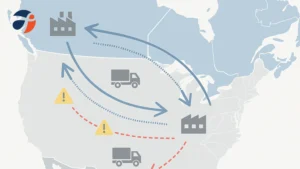With the right approach, supply chain planning can lower costs associated with several processes, including manufacturing, purchasing, inventory management, and logistics. Supply chain planning ensures well-organized operations, improves customer service by ensuring that products get to the end consumer without delays, meets customer demand and ultimately builds brand loyalty.
While businesses of all sizes need to adopt supply chain planning, there must be provision for a comprehensive supply chain management that includes demand, supply, production, and logistics. For a supply chain firm to implement effective supply chain operations to plan for high demand, the different departments and processes involved must be in coordination.
Here are the critical functions of the different processes involved in supply chain management that influence high demand.
Demand Planning Functions
 In supply chain operations, demand planning is the foundation for subsequent supply chain processes. It is heavily relied on by supply planning to help in forecasting customer demand. It involves the evaluation of various data to accurately forecast customer demand, which can then be used to analyze, maintain and store maximum inventory while avoiding costs associated with excesses.
In supply chain operations, demand planning is the foundation for subsequent supply chain processes. It is heavily relied on by supply planning to help in forecasting customer demand. It involves the evaluation of various data to accurately forecast customer demand, which can then be used to analyze, maintain and store maximum inventory while avoiding costs associated with excesses.
Demand planners take into consideration a larger amount of data from several sources when making their forecasts. These may include historical data, past sales data and the impact of distribution centers. This data can be turned into two types of demand projections. Constrained and unconstrained demand forecasting, which shows the maximum demand potential with and without limitations in production capacity and capital output respectively.
The use of integrated business planning and machine learning logistics software allows companies to employ both constrained and unconstrained demand forecasting. Utilizing both lets businesses estimate future sales and improves inventory optimization.
Supply Planning Functions
Supply chain planning is the forward-looking process of coordinating assets to optimize the delivery of goods, services and information from supplier to customer, and balancing supply and demand.
Hence, supply planning can only work with a demand plan in place. Supply planning is used to fulfill the demand plan while meeting the standards of the organization concerning all the inventory production and logistics factors, some of which may include:
- Setting minimum order quantities,
- Setting expected lead times in manufacturing products,
- Sourcing raw materials,
- Supervising safety stocks and leveling production.
Supply planners aim to meet the overall requirement of the business, ultimately meeting the demand for the product in the best possible way.
Production Planning Functions
Production planning creates an efficient process for production according to organizational and customer needs. It aids in the optimization of customer-dependent processes, such as on-time delivery and customer-independent processes, such as production cycle time.
A good production plan minimizes lead time, which in supply management is the amount of time it takes for parts to ship from a supplier to the manufacturer. The production planning process involves the following steps:
- The estimation of product demand using historical production trends with new potential trends in the market gives a rough outline of the number of products to be produced in a given period.
- Avoiding waste by effectively using resources based on projected demand estimates.
- Choosing the most efficient option such as resources that are least costly and time-efficient.
- Monitoring of the calculated result compared to the actual result and evaluating how well the two match up.
- Altering and adjusting plans to further improve future productions and more efficiently meet customer satisfaction
With the evolution of customer demands, the technology surrounding production has also evolved enabling more precision and information for organizations to consider when creating their production plans.
The Functions of Sales and Operations Planning (S&OP)
Sales and operations planning unifies diverse business teams working on different aims and objectives. It helps the different leaders of the supply chain assess and merge their plans together.
With the new dawn of digital transformation, the sales and operations planning software can help integrate your supply chain processes to create a cross-functionality throughout the entire team on your supply chain demand. It collects and analyzes real-time data from separate departments including sales, marketing, manufacturing and distribution to better optimize demand planning, supply planning and inventory planning.
Sales and operation planning go beyond the statistical forecasting approach. Just like how demand planning is the foundation of the supply chain processes, S&OP is the body of bricks encompassing the entire supply chain operations and turning it into a single plan, taking into account, revenue, profit projections and marketing events.
Supply and Demand Planning Is Essential
Figuring out your supply and demand planning is essential for a successful business. Without foresight and preparedness, businesses get exposed to new risks during unforeseen events. A comprehensive supply chain plan enables organizations to thrive in a manner that ensures seamless operations.
Frequently Asked Questions
1. What is supply chain planning?
Supply chain planning is the process of accurately planning the journey of a product right from the inception stage (e.g., sourcing for raw materials) to the final stage to reaching the end consumer. Comprehensive supply chain planning can help organizations achieve optimal supply chain goals, such as working capital optimization, material management, and waste elimination, all of which aid operational successes.
2. What are supply chain planning systems?
The supply chain planning system is the backbone of an organization, and optimizing it is a requirement to maintain a competitive advantage. To manage the complexity of supply chain planning, a set of information technology tools can be used directly or indirectly. These systems are used for inventory management, order fulfillment, order tracking, information integration, logistics planning and coordination. One of the leading information technology tools for supply chain planning is the Advanced Planning and Scheduling (APS) system.
It focuses on how to synchronize different planning decisions at strategic and operational levels of the end-to-end supply chain, resulting in 100% real-time visibility that leaves nothing hidden or up to chance. After adopting these technologies, organizations are better positioned to meet customer demands, shorten production life-cycle and stay relevant amidst market fluctuations.



